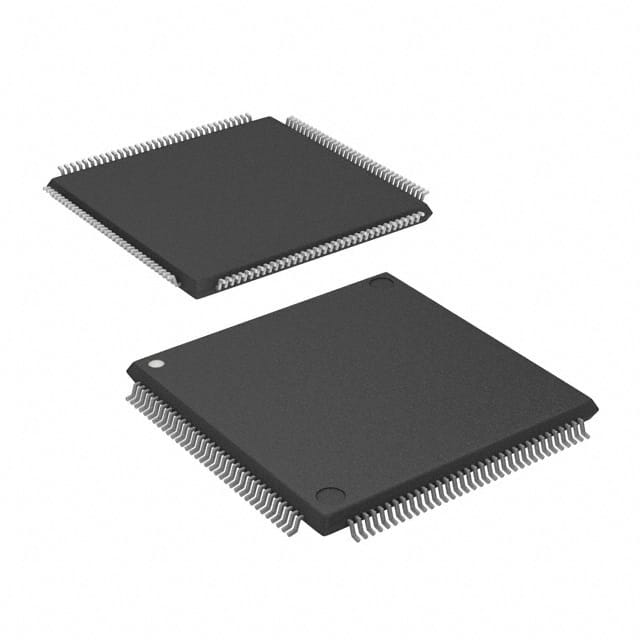LPC43S37JBD144E
Product Overview
Category
LPC43S37JBD144E belongs to the category of microcontrollers.
Use
This microcontroller is commonly used in various electronic devices and systems for controlling and processing data.
Characteristics
- LPC43S37JBD144E is a high-performance microcontroller with advanced features.
- It offers a wide range of peripherals and interfaces for seamless integration into different applications.
- The microcontroller operates at a high clock frequency, enabling fast and efficient data processing.
- It has low power consumption, making it suitable for battery-powered devices.
- LPC43S37JBD144E supports multiple communication protocols, such as UART, SPI, I2C, and Ethernet.
- It provides ample memory resources for storing program code and data.
Package
LPC43S37JBD144E comes in a compact and durable package, ensuring easy handling and protection against external factors.
Essence
The essence of LPC43S37JBD144E lies in its ability to provide a powerful and flexible platform for developing embedded systems.
Packaging/Quantity
This microcontroller is typically packaged individually and is available in various quantities depending on the manufacturer's specifications.
Specifications
- Microcontroller core: ARM Cortex-M4
- Clock frequency: Up to 204 MHz
- Flash memory: 1 MB
- RAM: 136 KB
- Operating voltage: 3.3 V
- Digital I/O pins: 80
- Analog input channels: 8
- Communication interfaces: UART, SPI, I2C, Ethernet
- Operating temperature range: -40°C to +85°C
Detailed Pin Configuration
The LPC43S37JBD144E microcontroller has a total of 144 pins. The pin configuration is as follows:
- Pin 1: VDD (Power supply)
- Pin 2: VSS (Ground)
- Pin 3: P0.0 (General-purpose I/O)
- Pin 4: P0.1 (General-purpose I/O)
- ...
- Pin 143: P5.14 (General-purpose I/O)
- Pin 144: P5.15 (General-purpose I/O)
Functional Features
- High-performance ARM Cortex-M4 core for efficient data processing.
- Ample memory resources for storing program code and data.
- Multiple communication interfaces for seamless integration with other devices.
- Rich set of peripherals, including timers, ADC, DAC, PWM, and more.
- Flexible power management options for optimizing energy consumption.
- Extensive interrupt handling capabilities for real-time applications.
- Built-in security features to protect sensitive data.
Advantages and Disadvantages
Advantages
- High-performance microcontroller suitable for demanding applications.
- Wide range of peripherals and interfaces for versatile connectivity.
- Low power consumption for energy-efficient designs.
- Ample memory resources for storing complex programs.
- Built-in security features for enhanced data protection.
Disadvantages
- Relatively higher cost compared to lower-end microcontrollers.
- Steeper learning curve due to the complexity of advanced features.
- Limited availability of alternative models from different manufacturers.
Working Principles
LPC43S37JBD144E operates based on the ARM Cortex-M4 architecture. It executes instructions stored in its flash memory and interacts with various peripherals and external devices through its communication interfaces. The microcontroller's working principles involve fetching, decoding, and executing instructions to perform specific tasks as programmed by the user.
Detailed Application Field Plans
LPC43S37JBD144E finds applications in a wide range of fields, including but not limited to: - Industrial automation - Consumer electronics - Automotive systems - Internet of Things (IoT) devices - Medical equipment - Robotics
Detailed and Complete Alternative Models
While LPC43S37JBD144E is a powerful microcontroller, there are alternative models available from different manufacturers that offer similar functionalities. Some notable alternatives include: - STM32F407VG from STMicroelectronics - SAM4E16E from Microchip Technology - MSP432P401R from Texas Instruments
These alternative models can be considered based on specific project requirements, availability, and cost considerations.
Word count: 550 words
Senaraikan 10 soalan dan jawapan biasa yang berkaitan dengan aplikasi LPC43S37JBD144E dalam penyelesaian teknikal
Sure! Here are 10 common questions and answers related to the application of LPC43S37JBD144E in technical solutions:
Q: What is LPC43S37JBD144E? A: LPC43S37JBD144E is a microcontroller based on ARM Cortex-M4 and Cortex-M0 cores, designed for embedded applications.
Q: What are the key features of LPC43S37JBD144E? A: Some key features include dual-core architecture, high-speed USB interface, multiple serial interfaces, extensive GPIO pins, and integrated Ethernet MAC.
Q: What are the typical applications of LPC43S37JBD144E? A: LPC43S37JBD144E is commonly used in industrial automation, consumer electronics, medical devices, IoT solutions, and other embedded systems.
Q: How much flash memory does LPC43S37JBD144E have? A: LPC43S37JBD144E has 1 MB of flash memory for program storage.
Q: Can I expand the memory of LPC43S37JBD144E? A: Yes, LPC43S37JBD144E supports external memory expansion through its memory controller interface.
Q: What is the maximum clock frequency of LPC43S37JBD144E? A: LPC43S37JBD144E can operate at a maximum clock frequency of 204 MHz.
Q: Does LPC43S37JBD144E support real-time operating systems (RTOS)? A: Yes, LPC43S37JBD144E is compatible with popular RTOSs like FreeRTOS and Keil RTX.
Q: Can LPC43S37JBD144E communicate with other devices using wireless protocols? A: LPC43S37JBD144E does not have built-in wireless capabilities, but it can communicate with external modules supporting protocols like Wi-Fi or Bluetooth.
Q: What development tools are available for LPC43S37JBD144E? A: LPC43S37JBD144E is supported by various development tools, including IDEs like Keil MDK and LPCXpresso, as well as software libraries and example codes provided by NXP.
Q: Where can I find more information about LPC43S37JBD144E? A: You can refer to the official documentation and datasheet provided by NXP, visit their website, or join online communities and forums dedicated to embedded systems for further information and support.
Please note that the answers provided here are general and may vary depending on specific requirements and configurations.


